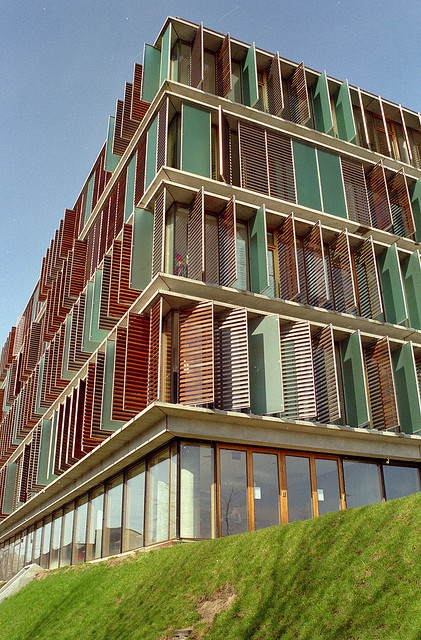For centuries, windows have been a mainstay in architecture, offering us a glimpse of the outside world and allowing natural light to flood our homes and buildings. But what if windows could do more?
Believe it or not, this futuristic vision is no longer science fiction. Recent advancements in material science are paving the way for solar windows, a revolutionary technology that harnesses the power of the sun and transforms your windows into mini-power plants!

Transparent solar panels
Transparent solar panels look like clear glass and let light through like regular windows.
But they’re made with a type of solar glass that absorbs ultraviolet and infrared light – types of light that aren’t visible to the naked eye – and turn these into renewable electricity.
Researchers at Michigan State University developed the first fully transparent solar panel in 2014.

The future of high-tech windows
For example, the Copenhagen International School’s design utilizes 12,000 hued but clear solar panels all over the building, producing 200 MWh of energy annually — that’s apparently more than half of the energy the building consumes.

In another example , the Biomedical and Physical Sciences Building on the campus of Michigan State University was upgraded with the installation of 100-square-feet transparent solar glass panels which were situated above the building’s entryway. They will generate enough electricity to power the lighting in its atrium.
What are the benefits?
See-through solar panels are incredibly important as, in modern society, glass is practically everywhere. Ranging from the screen of your phone to skyscrapers, it’s estimated that there are 5 to 7 billion square meters of glass surfaces in the United States. Imagine the sheer amounts of electricity that could be generated if we could tap into that power.
With that in mind, it should also be noted that conventional solar panels necessitate a wide setup area as well as a significant initial cost. Because of these constraints, it is difficult to implement them in metropolitan locations. Transparent solar panels, on the other hand, can be implemented in these areas, paving the way for net-zero energy buildings and help cities meet climate goals and targets.
Solar glass has benefits over solar panels
A key advantage of solar glass – also known as photovoltaic glass – is that it takes up less space than traditional solar panels.In cities with lots of buildings and limited space, setting up traditional solar panel installations is difficult, Interesting Engineering explains.Transparent solar panels, on the other hand, can be widely fitted even in cramped cities, helping buildings and cities meet net zero climate goals.
As solar glass engineer Richard Lunt explains: “You could turn nearly every surface of a building or landscape into a solar array and generate power right where you use it without even knowing that it’s there.”
Skyscrapers could become solar farms
The US alone is estimated to have between five and seven billion square metres of glass surface.
Skyscrapers, for example, have a “massive amount of glass surface”, notes solar energy publication, Solar Magazine.
The potential for buildings like these to generate clean, renewable energy from the sun is enormous, the magazine adds.
Europe is opening up to solar windows
Solar windows are also taking off in Europe.
A Netherlands-based company called Physee says it is installing 15,000 of its ‘SmartWindows’ in office buildings across Europe. These are windows that contain both power-generating solar cells and sensor technology that helps manage the building’s energy use and comfort. The windows will cut building energy costs by up to 30%, Physee says. Europe is opening up to solar windows
Transparent solar panels are already in use at Copenhagen International School, a day school in Denmark. The building is covered in 12,000 “hued but clear” solar panels, explains engineering site Interesting Engineering.
These provide 200 megawatts of electricity a year – more than half the energy the building consumes.
But how can you interact with this exciting technology?
Let’s imagine you’re thinking about incorporating transparent solar panels into your home or building. Here are some questions you might have:
- Are transparent solar panels as effective as traditional rooftop panels?
Not quite yet! While the technology is rapidly evolving, transparent solar panels currently generate less power compared to their rooftop counterparts. However, research is ongoing, and efficiency is constantly improving.
- Do transparent solar panels compromise my view or the amount of natural light coming in?
There can be a slight tint to some transparent solar panels, but advancements are minimizing this effect. The amount of natural light entering your space might be slightly reduced, but it’s often negligible compared to the benefits.
- How much do transparent solar panels cost?
As with any new technology, the upfront cost can be higher than traditional windows. However, with increasing adoption and advancements, costs are expected to come down. Remember, the long-term energy savings and environmental benefits can be significant.
By working together, we can help turn this vision into reality and create a future where windows are no longer just openings to the world, but active contributors to a brighter and more sustainable tommorow!
Leave a comment